10 Simple Exercises & Stretches
to Keep Your Knees Strong and Healthy
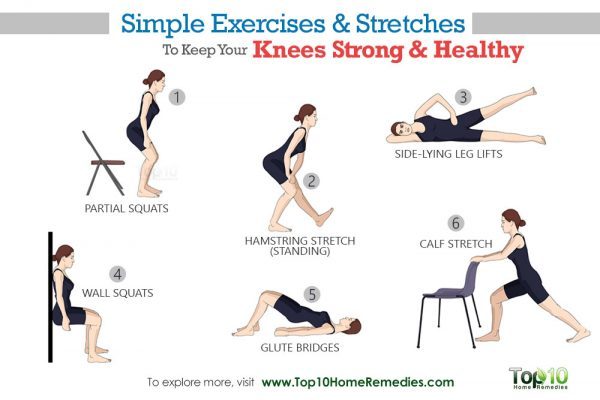

Strong knees balance your body and help you maintain a correct posture. The importance of healthy knees, however, is often unrecognized until there’s a problem. And the knees are the most commonly injured joints in the body.
Anyone, irrespective of age, can face trouble with their knees at some point in time. Playing sports, following a rigorous exercise routine or participating in other activities can cause muscle strains or ligament tears leading to knee problems.
For some, the pain can be severe enough to restrict daily activities, while for others it may be just mild. In either case, you must not ignore knee problems lest they might turn severe.
Knee problems are not always a result of issues in the actual knee joints. Any kind of tear or rupture in and around the muscles in your thighs may reach up to your knees to create troubles.
All the muscles and joints near the knees are closely related in maintaining the knees in a healthy state. Therefore, it is important to exercise the area around the knees.
Exercising the quadriceps (front of the thighs), hamstrings (back of the thighs), abductors (outer side of the thighs) and adductors (inner side of the thighs) helps maintain the health of your knees.
If these muscles are in good shape, your knees will automatically be functioning well and will be less susceptible to injury.
Here are 10 simple knee-strengthening exercises that can be easily practiced at home.
🦵
1. Partial Squats
Squats are your best friend when it comes to knee troubles. In fact, it is one of the best exercises for rehabilitation of the knee. Partial squats help train the leg muscles and also improve balance and coordination.
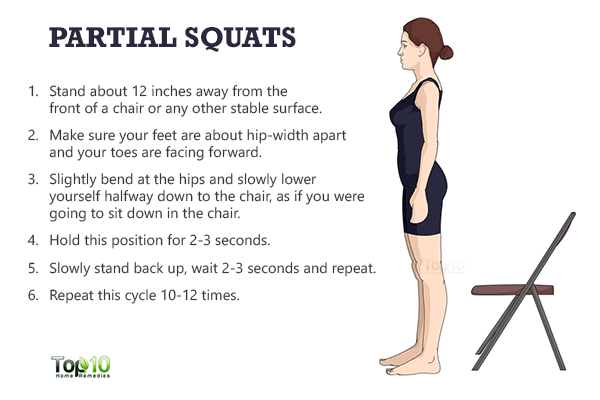
A 2014 study published in the Journal of Strength and Conditioning Research suggests that partial squats may be beneficial for strength and power athletes during a strength-speed mesocycle while peaking for competition.
Experts suggest that partial squats are more effective when carried out before and in conjunction with higher-intensity exercises of your overall training progression.
Stand about 12 inches away from the front of a chair or any other stable surface.
Make sure your feet are about hip-width apart and your toes are facing forward.
Slightly bend at the hips and slowly lower yourself halfway down to the chair, as if you were going to sit down in the chair.
- Hold this position for 2 or 3 seconds.
- Slowly stand back up, wait 2 or 3 seconds and repeat.
- Repeat this cycle 10 to 12 times.
🦵
2. Hamstring Stretch (Standing)
The hamstrings are an important knee-stabilizing group of muscles that run down the back side of the thighs to the knees. The hamstring muscles work together to flex and bend the knee joint and to extend the hip joint.
Thus, the hamstring stretch is a good exercise to strengthen the muscles and support smooth knee functioning. There are multiple variations of this exercise routine. You can choose one as per your ease and concerns.
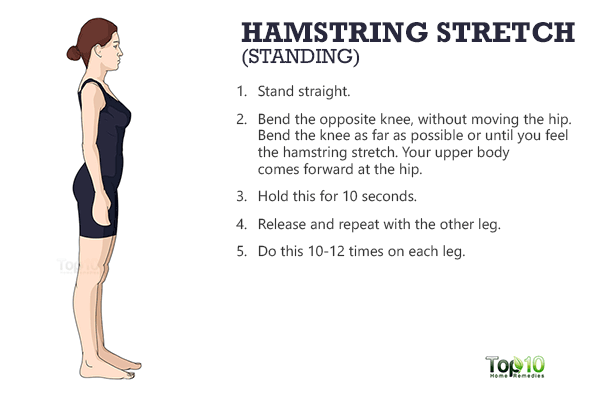
A 2004 study published in the Journal of Athletic Training found that the standing and supine hamstring stretches were comparably effective in improving flexibility as measured by increasing range of motion at the knee.
A 2013 study published in the European Journal of Orthopaedic Surgery & Traumatology also found that standing stretches are better than seated stretches when it comes to hamstrings.
Stand straight and put one foot forward, toes up.
Bend the opposite knee, without moving the hip. Bend the knee as far as possible or until you feel the hamstring stretch. Your upper body comes forward at the hip.
- Hold this position for 10 seconds.
- Release and repeat with the other leg.
- Do this 10 to 12 times on each leg.
Note: Do not stretch or twist your back.
🦵
3. Marching in Place
One easy exercise that suits people of different age groups and knee conditions is marching in place. It requires no specialized equipment and provides an option for at-home exercise or you can do it at a beach or park.
Marching in place is a great exercise to help relieve knee pain. It helps increase the strength of your quads without actually putting any weight through the knee joints.
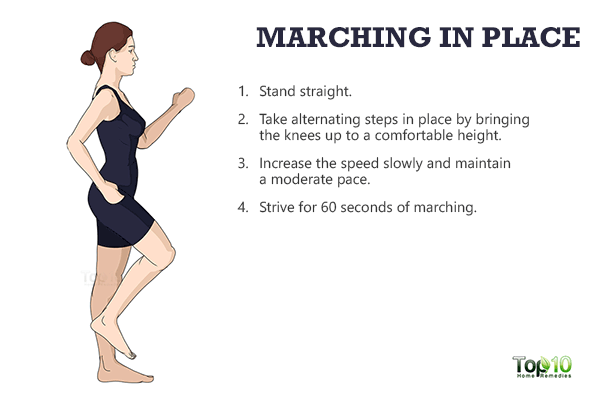
It is also good for improving your balance as well as your heart health and weight management.
- Stand straight.
- Take alternating steps in place by bringing the knees up to a comfortable height.
- Increase the speed slowly and maintain a moderate pace.
- Strive for 60 seconds of marching.
Preferably, do this exercise while wearing your walking shoes and holding a chair.
🦵
4. Calf Raises
A very common injury associated with the knee is a torn meniscus.
The meniscus is a C-shaped piece of cartilage on either side of the knee joint, sitting between the larger of two lower leg bones and the upper leg bone. It is more prone to injuries due to twisting of the knee or other degenerative changes.
Calf raises help the meniscus by strengthening the muscles that surround and stabilize the knee.
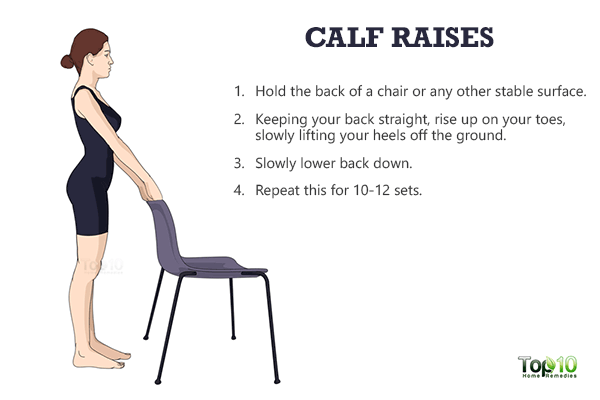
Further, they help the ankle muscles in improving coordination and balance, thus keeping the knee aligned in a proper plane. They put minimal pressure on the knee and are ideal for recovering from a damaged meniscus.
- Hold the back of a chair or any other stable surface.
- Keeping your back straight, rise up on your toes, slowly lifting your heels off the ground.
- Slowly lower back down.
- Repeat this for 10 to 12 sets.
🦵
5. Straight Leg Lifts
Straight leg lifts help improve the stability of knee joints by strengthening the quadricep muscles in your thighs. And the stronger your quads, the more control they have over your knees.
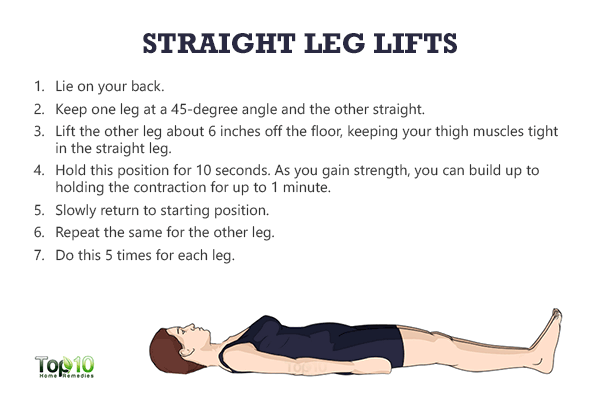
Warm up with a low-impact activity, such as walking or cycling, before doing this exercise.
- Lie on your back.
- Keep one leg at a 45-degree angle and the other straight.
- Lift the other leg about 6 inches off the floor, keeping your thigh muscles tight in the straight leg.
- Hold this position for 10 seconds. As you gain strength, you can build up to holding the contraction for up to 1 minute.
- Slowly return to starting position.
- Repeat the same for the other leg.
- Do this 5 times for each leg.
During this exercise try to keep your upper body relaxed and tighten your stomach muscles. Never arch your back.
Note: Do not practice this exercise if you have a history of back problems.
🦵
6. Step Ups
Step ups are a great knee-strengthening exercise that helps improve knee stability and strengthens the quadriceps. Strengthening the adjoining muscles helps decrease the strain on the knee joints, thus relieving your pain.

You may use an aerobic step bench or a staircase for this exercise.
- Stand in front of a step with your feet about hip-width apart.
- Step up onto the step with your left foot.
- Tap your right foot on the top of the step and then lower it.
- Repeat with your right foot.
- Do 20 to 30 repetitions.
🦵
7. Side-Lying Leg Lifts
This exercise primarily targets your abductor muscles (the outer side of the thighs) that are important for playing sports and conducting your daily activities. It works on creating tension in your gluteus medius (outer thigh), which helps make them stronger and more stable.

The exercise is also effective for toning the hip area.
- Lie down on one side with your legs stacked and straight.
- Support your head with your left arm.
- Keeping the top leg straight, slowly lift it to about 45 degrees.
- Hold this position for 20 seconds.
- Slowly lower the leg and relax for a couple of seconds.
- Repeat 10 to 15 times.
- Switch sides and start over with the other leg.
- Do 15 to 20 sets of this exercise every day.
🦵
8. Glute Bridges
Strong gluteals are essential for healthy functioning knees. They help control the movement of the knees by preventing them from collapsing inwards. Thus, they form the very foundation for strong knees. Weak or inactive glutes may cause all sorts of problems in your knees.
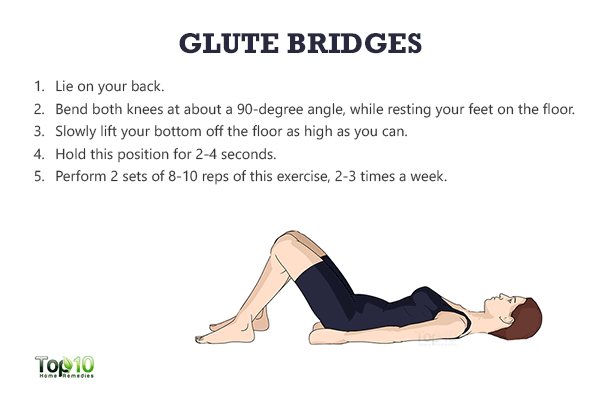
Bridge, as a form of exercise, works on strengthening your glutes, hamstrings and abs, while putting minimal to no pressure on the knees.
- Lie on your back.
- Bend both knees at about a 90-degree angle, while resting your feet on the floor.
- Slowly lift your bottom off the floor as high as you can. (Do not arch your back and make sure your shoulders, hips and knees align).
- Hold this position for 2 or 4 seconds.
- Perform 2 sets of 8 to 10 reps of this exercise, 2 or 3 times a week.
The single-leg glute bridge is also considered as one of the best exercises for hip stability. This exercise is also effective at keeping knee pain and other problems at bay.
9. Wall Squats
Squats are the best exercise to help you assess the strengths and weaknesses within your knee joints. However, wall squats are the best as less force goes through the knees when performing them. Also, this exercise is simply perfect for anyone suffering from knee pain.
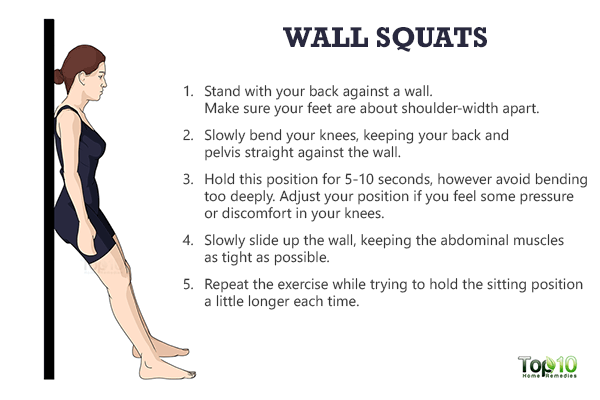
Although the exercise places pressure on the knees with repetitive bending, it helps in protecting your delicate joints and muscles in and around them. This exercise is specifically a boon for runners and athletes or those with runner’s knee injury.
A 2016 study published in the Journal of Physical Therapy Science reports that use of the wall squat also aids in the control of common compensation patterns, such as pelvic rotations, dynamic valgus and weight-bearing deviations in the feet observed in the training environment.
- Stand with your back against a wall. Make sure your feet are about shoulder-width apart.
- Slowly bend your knees, keeping your back and pelvis straight against the wall.
- Hold this position for 5 to 10 seconds, however avoid bending too deeply. Adjust your position if you feel some pressure or discomfort in your knees.
- Slowly slide up the wall, keeping the abdominal muscles as tight as possible.
- Repeat the exercise while trying to hold the sitting position a little longer each time.
If possible, try to do this exercise with a Swiss ball. A 2011 study published in the British Journal of Sports Medicine reports that use of a Swiss ball during the wall squat exercise has additional benefit on lower limb muscle activity.
Note: Do not slide your hips down lower than your knees.
🦵
10. Calf Stretch (Gastrocnemius Stretch)
Calf muscles play a significant role in supporting your knees, as well as in reducing pain and improving flexibility.
The calves are made up of two muscles on the back of your lower legs–the gastrocnemius and soleus. The main job of these muscles is to pull the foot down, like when you point your toes.

However, these are often neglected during workouts and exercise routines. And a pain in the calf muscles can be extremely tight and might even travel up to the knees.
So, it is important to take care of your calves and loosen them up to avoid any kind of pain or trouble in the knees. Stretching is one form of exercise that can keep these muscles loose and relieve pain in the muscles and knees.
Plus, it is beneficial for treatment of plantar fascia. A 2013 study published in the Journal of Sport Rehabilitation found that gastrocnemius-soleus stretching should be considered as supplemental to plantar fascia-specific stretching.
- Hold onto a chair or any other stable surface for balance.
- Bend your right leg.
- Step back with your left leg.
- Slowly straighten your left leg behind you.
- Press your left heel toward the floor. You will feel the stretch in the calf of your back leg.
- Hold for 20 seconds.
- Repeat twice, and then switch legs.
🦵 🦵🏼 🧎🏻 🦵🏻 🤸♂️ 🦵 🦵🏽
Resources:
Resources:
- http://www.uhs.nhs.uk/Media/Controlleddocuments/Patientinformation/Medicines therapies and anaesthetics/Knee strengthening exercises-patientinfo.pdf
- http://www.ncbi.nlm.nih.gov/pubmed/24662234
- https://thrive.kaiserpermanente.org/care-near-you/northern-california/santarosa/wp-content/uploads/sites/15/2015/09/010526-034CL_tcm75-133788.pdf
- http://www.ncbi.nlm.nih.gov/pmc/articles/PMC535525/
- http://www.ncbi.nlm.nih.gov/pubmed/23412177
- http://www.scielo.br/scielo.php?pid=S1413-78522005000400002&script=sci_arttext&tlng=en
- https://www.jstage.jst.go.jp/article/jpts/28/6/28_jpts-2015-1090/_pdf
- http://bjsm.bmj.com/content/45/2/e1.56.abstract
- http://www.ncbi.nlm.nih.gov/pubmed/19276845
- http://www.naspspa.org/AcuCustom/Sitename/Documents/Document Item/11_Garrett_jsr_2012-0110_308-312-ej.pdf
- http://www.ncbi.nlm.nih.gov/pubmed/21344812
🦵 🦵🏼 🧎🏻 🦵🏻 🤸♂️ 🦵 🦵🏽🦵 🦵🏼 🧎🏻 🦵🏻 🤸♂️ 🦵 🦵🏽

No comments:
Post a Comment